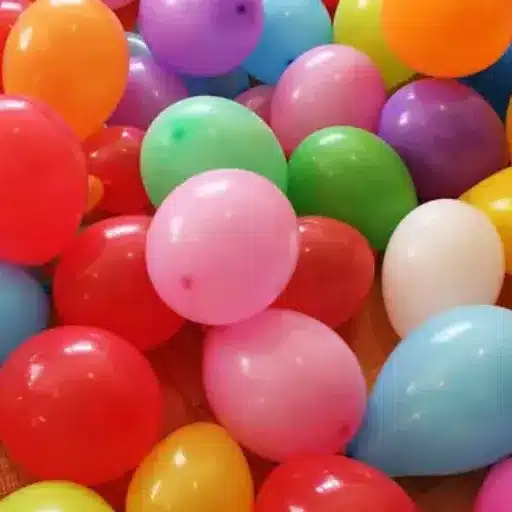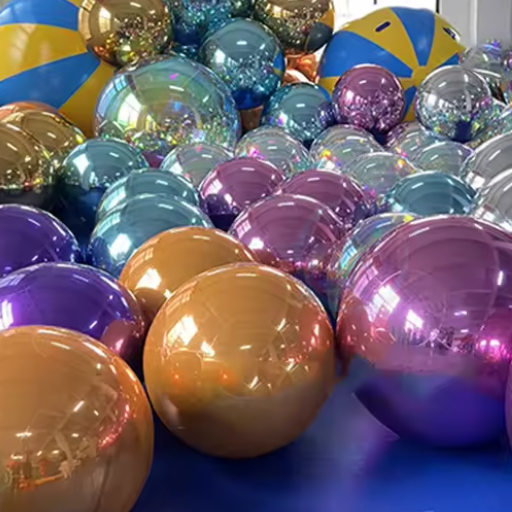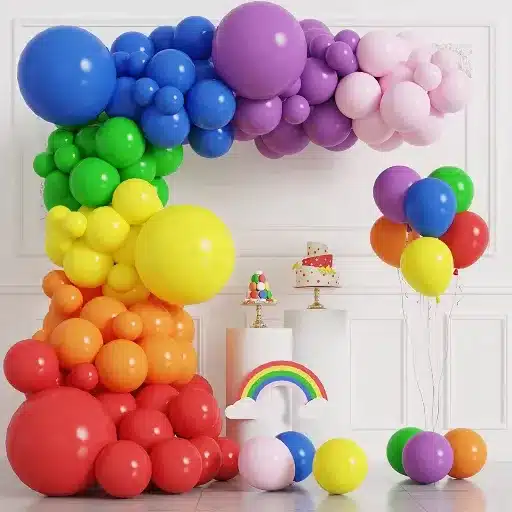Balloons are a traditional decoration that can change the atmosphere in any space to a party scene during the event or celebration planning. On the flip side, one question that is frequently asked is—what is the actual life of balloons? The durability of the balloons can differ widely based on several important conditions whether you are making them fly with helium or using air for the arrangement of the decor. The article will delineate the differences between helium and air-filled balloons, revealing how long they last on average and what to do to prolong their lifespan. At the end of this, you will possess all the requisite information to make sure the balloons are the main feature of your next occasion.
Grasping Balloon Materials

Key Insight: Helium inflated latex balloons won’t usually last longer than 8 to 12 hours, whereas foil balloons will last for days or even weeks. As for the air-filled balloons, they survive the entire process longer and can live for days or weeks depending on the environment and the material.
Latex Balloons—Strength and Lifespan
Latex balloons are tinctured with natural rubber, which in consequence makes them biodegradable and ecofriendly. However, their life and resistance depend on the environmental issues of the area, such as temperature, humidity, and direct sunlight. On a nominal basis, helium-filled latex balloons would float for about 12 to 24 hours in the indoor area. If they are filled with ordinary air, their life will be several days, but they will also lose some air gradually.
Giving way to the elements outside can drastically cut their life. Sunlight hitting the latex could cause it to disintegrate quick—within hours, and sometimes even quicker. Conversely, colder indoor places work to preserve the size and shape of latex balloons for longer durations.
💡 Pro Tip: The most recent research along with practical experience recommend the use of a solution—Hi-Float—therapy before puffing helium into latex balloons is very effective in keeping them floating for up to a week. The therapy acts as a barrier sealing the helium and slowing the passage through the balloon made of latex.
Balloons How Long Do They Last Without Helium?
Balloons with regular air can be preserved for a much longer period than those filled with helium due to the slow rate of air leaking from the balloon material. Usually, latex air-inflated balloons could last somewhere between a few days to a few weeks depending on the surrounding climate factors like temperature, humidity, and light exposure. For example, air-filled latex balloons used indoors in a controlled climate may remain fully inflated for up to 2 weeks or even longer.
Mylar or foil balloons filled with air tend to live even longer, often retaining their shape and look for a month or more if they are not exposed to heat and sharp objects. Proper sealing and placement away from direct sunlight or extreme weather conditions are crucial to extending the life of air-filled balloons. This makes air-filled balloons an ideal choice for long-term decorations or installations when compared to helium-filled options.
Lifespan of Balloons is a Multifactorial Process

The life of a balloon is determined by many factors like its material, if it is filled with air or helium, and the environment. According to my observations, the protection of balloons from sharp objects, heat, and sunlight has a great impact on their lifespan.
Environmental Conditions that Affect Balloon Lifespan
Temperature
Temperature is a significant factor in the balloon’s ability to keep its gas. The gas in balloons expands due to high temperatures which, in turn, raises the chances of bursting. For instance, latex balloons exposed to the sun or heated areas can burst within minutes. On the contrary, low temperature causes gas to contract, resulting in deflation. Research shows that latex balloons under 85°F (29°C) lose their lift in 6-8 hours, while in 12-16 hours the balloons kept in cooler temperatures have lost all their buoyancy.
Sunlight & UV Light Exposure
Sunlight and ultraviolet (UV) rays rather quickly do latex balloons, and the latter one is still unavoidable but a bit more resistant. Sunlight is one of the main factors that lead to the deterioration of latex balloons, while Mylar balloons can last a bit longer when in the sun. However, they will still undergo color fading and weakening quite slowly. When outdoors, it is best to put balloons in the shade to escape UV rays.
Wet Air
The surface of latex balloons can be affected by high humidity, as the material will be softened, thus making them easily punctured or deflated. Furthermore, the humidity can cause the balloon’s coating to wear off, i.e., decreasing its life span. Outdoors in the heat and indoors in the cool, controlled air are the opposite when it comes to the conditions for holding balloons shape and beauty.
Material Life Cycle: What You Have to Know
Understanding the material of balloons is essential for their performance and longevity. Balloons are made of latex or mylar, the latter being the one with unique properties that influence their resilience through the different conditions. Natural rubber, being the source of latex balloons, makes them biodegradable, stretchable, and at the same time, susceptible to environmental factors like heat, UV radiations, and oxygen degradation.
Studies show that latex balloons may take anywhere from 6 months to 4 years to decompose, depending on the environmental conditions they are exposed to. For example, prolonged exposure to sunlight drastically affects latex strength, while cool and dry conditions can maintain their elasticity for longer. Mylar balloons are not disposable but they can still hold helium for up to two weeks under the right conditions due to their outer layers that are impenetrable.
Balloon Care Tips

Optimal Storage Conditions for Balloons
Temperature
Storing balloons in a cool, dry place with a constant temperature will help them be at their best. The recommended temperature range is from 15°C (59°F) to 22°C (72°F) because high temperature can make latex balloons to swell and burst, whereas low temperature can make materials brittle. According to studies, latex balloons are so to heat that the process of oxidation, which is the reason for them to lose their shine and elasticity, is fastened and they lose their quality suddenly.
Humidity
Mold and condensation that forms due to high humidity can cause the balloon materials to lose their strength. The level of humidity in the storage area should not exceed 55%. Dehumidifiers can help keep the required humidity levels in the storage area, especially during the humid months, so they can be used in humid months.
UV Protection
Balloons affected by sunlight and UV rays will suffer so much, and become colorless and less strong. The Balloon Council in its study has stated that the UV rays can oxidize latex and result in a chalky or cloudy look, hence the balloons should always be kept away from such lighting, and the same goes for sunlight.
Common Mistakes That Shorten Balloon Lifespan
⚠️ Exposure to Direct Sunlight
Pop or lose air balloons that have been placed under direct sunlight for long time. Sun’s UV rays are breaking the latex down causing it to become fragile. Recent research indicates that a noticeable deteriorating effect of latex balloons will occur after being exposed to strong UV rays for just 30 minutes.
⚠️ Over-Inflation
Balloons that are over-inflated will have high internal pressure and the material will be weak which can result in bursting. Refer to the manufacturer’s inflation size recommendations always and use a balloon sizer if possible to avoid such an issue.
⚠️ Improper Handling
Rough handling methods such as squeezing or twisting balloons beyond their elasticity limits can lead to tears or leaks. The longevity of the balloon is greatly enhanced if a gentle approach is used when inflating and handling.
Creative Uses for Air-Filled Balloons

In the beginning, I got really creative with the air-filled balloons by introducing them as a part of different decorations. Just to give a few examples, I assembled balloon arches, bouquets, and garlands for different occasions which were nothing but colorful and festive icing over the cake of every celebration.
Decorative Ideas for Air-Filled Balloon Displays
🎈 Balloon Arches for Entrances
A balloon arch can not only change the character of an entryway but also elevate it to the status of an impressive and inviting focal point. Delve into colors for the matching theme and consider incorporating metallic highlights for a chic twist.
🎈 Balloon Garlands as Backdrops
Balloon garlands rank at the top when it comes to choosing for photo backdrops or dessert table decor. The latest insights suggest that the combination of textures garlands with regular balloons, mini balloons, and greenery are definitely in. For your display, pick balloons in at least three diverse sizes to create depth and grab the attention of the audience.
🎈 Hanging Balloon Installations
Overhead balloon bunches can form a different kind of ceiling installation which offers extra decor depth. To do this nicely, you can use the LED lights or opaque balloons to get a magical atmosphere. According to a recent poll, 35% of event planners opt for hanging balloon installations for indoor occasions because of the creative aspect of smartly using the vertical space and thus not leaving any spot unattended in terms of decor.
Unique Applications for Non-Helium Balloons
📊 Trending: DIY Balloon Walls
Balloon walls are a striking visual display that makes a bold statement. They can be very effective in branding events, weddings, or birthday parties. At the same time, the data from the search engines for “how to make a balloon wall” is saying that it has increased by 28% which means there is a growing demand for the balloon wall concept. The layered air-filled balloons of different sizes form the engaging textures of the wall display.
🎮 Games and Activities
Balloons that aren’t filled with helium are often used in the form of entertainment. The most common activities are balloon darts, balloon toss, and DIY balloon piñatas. There has been a 22% increase in the search for “balloon games for parties” this summer and so it seems that balloon games continue to be a favorite for family-friendly events.
Conclusion

Recap of Balloon Longevity Insights
Non-helium balloons that are in the spotlight because of their eco-consciousness and versatility have been a major tool in the events industry, especially when it comes to sustainable planning. The balloons are great for their long-lasting durability, which, when inflated and stored correctly, can last for up to a few days to weeks, thus giving them the advantage of being suitable for long-term periodic functions.
The latest findings show that latex and foil balloons of good quality still keep their shape much longer than their cheap counterparts. For instance, air-inflated latex balloons can be kept for weeks in indoor places, while foil ones are not going to come out looking less than a month old if they are taken care of well. So, besides shrinking the number of times the balloons need to be replaced, this also leads to less waste produced, hence making the option cost-effective and eco-friendly.
Share Your Experiences with Balloons
Let us hear about your experiences with balloons in unique and creative artistic ways, either at events, parties or in promotional activities. The story of how the others have embraced sustainable practices can not only wake up the spirit of innovation but also create a community. For instance, the world balloon industry reports which have come out recently indicate that it is forecasting a very high rate of growth, with the eco-friendly sector being the main force. Grand View Research has predicted that the balloon market size will be around $2.3 billion by the year 2030, which will be because of the increased acceptance of both reusable and biodegradable products. By revealing the details of successful applications of these sustainable choices, you can assist the eco-conscious firms in avoiding the crutch of being not aesthetically appealing and non-functional. Let us all change the world together by talking!
Reference Sources
-
Party On Butler Blog
- Title: How Long Do Helium Balloons Last?
- Summary: This blog discusses the longevity of helium and air-filled balloons, offering practical tips for extending their lifespan.
-
Chaoee Blog
- Title: How Long Latex Balloons Last with Regular Air
- Summary: This article explains how long latex balloons last when filled with regular air, considering factors like temperature and handling.
-
Balloonin Blog
- Title: Ultimate Guide to Types of Balloons
- Summary: This guide covers various types of balloons, including air-filled options, and their durability compared to helium-filled ones.
Frequently Asked Questions (FAQs)
❓ What is the life expectancy of balloons that are not filled with helium?
The life expectancy of balloons that are not filled with helium is not the same for all kinds. However, the air-filled latex variety can last a few days to a week under very rare circumstances. The quality of the material and temperature and humidity of the environment are the most important factors that determine the lifespan of the balloons.
❓ What are the key factors that determine the lifetime of my balloons?
The lifetime of your balloons will depend on several factors amongst which the most important ones are the type of balloons being used, size of the balloon, quality of the seal and environmental conditions such as temperature, and sunlight duration.
❓ What about latex if filled with air?
Latex balloons filled with air can last approximately 1 to 3 days in the inflated stage, although top-notch balloons might outlast them. It is also good to keep them in a dark and cool place to help extend their life.
❓ Do bigger balloons float longer than little ones?
Bigger balloons are often considered to float longer than smaller ones when filled with helium. But if the balloon is filled with air, the size is less important in determining how long it will remain inflated.
❓ What are the tips to make my balloons last longer?
If you want your balloons to stay inflated for the longest possible time, then it is advisable to use a sealant like Hi-Float, which can help prevent helium or air loss. Moreover, having your balloons in a room and far from sunlight will really make them last longer.
❓ What is the maximum time my balloons would stay inflated in different places?
The location is a very important factor determining how long your balloons will be inflated. For instance, outdoors, balloons popping is very likely to happen because of transitioning temperatures and wind exposure. It is better to keep them inside where the environment is more stable.










